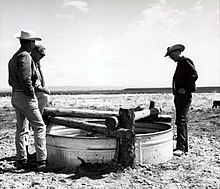Rangeland management

Rangeland management (also range management, range science, or arid-land management) is a
History
The earliest form of Rangeland Management is not formally deemed part of the natural science studied today, although its roots can be traced to
Rangeland management was developed in the United States in response to rangeland deterioration and in some cases,
Modern application

Global
Range management's focus has been expanded to include the host of
Pastoralism has become a contemporary anthropological and ecological study as it faces many threats including fragmentation of land, conversion of rangeland into urban development, lack of grazing movement, impending threats on global diversity, damage to species with large terrain, decreases in shared public goods, decreased biological movements, threats of a "tragedy of enclosures", limitation of key resources, reduced biomass and invasive plant species growth.[12] Interest in contemporary pastoralist cultures like the Maasai has continued to increase, especially because the traditional syncreticly-adaptive ability of pastoralists could promise lessons in collaborative and adaptive management for contemporary pastoralist societies threatened by globalization as well as for contemporary non-pastoralist societies that are managing livestock on rangelands.[13][14]

United States of America
The United States Society for Range Management is "the professional society dedicated to supporting persons who work with rangelands and have a commitment to their sustainable use".[15] The primary Rangeland Management publications include the Journal of Range Management, Rangelands, and Rangeland Ecology & Management.[16]
As
Australia
The Australian Rangeland Society is the peak group of rangeland professionals in Australia. It is an independent and non-aligned association of people interested in the management and sustainable use of rangelands.[26] Rangeland Management publications from the Society include The Rangeland Journal [27] and the Range Management Newsletter.[28]

Education and employment

In the United States, the study of range science is commonly offered at
. These courses are essential to entering a range science profession.Students with degrees in range science are eligible for a host of technician-type careers working for the federal government under the
See also
- Conservation grazing
- Land management
- Natural Resources Conservation Service
- Range condition scoring
- Wildlife management
- Upland pasture
References
- ^ Society for range Management. Society for Range Management, 2016. Web. 22 Apr. 2016.
- ^ Holechek, Jerry L., Rex D. Pieper, and Carlton H. Herbel. Range Management: Principles and Practices (6th Edition). 6th ed. N.p.: Pearson, 2011. 5. Print.
- ^ Vasey, Daniel A. (1992). An Ecological History of Agriculture 10,000 B.C.-A.D. 10,000. Ames, Iowa: Iowa State University Press. p. 23.
- ^ Stephen Wroe , Judith Field , Richard Fullagar , Lars S. Jermin. "Megafaunal extinction in the late Quaternary and the global overkill hypothesis." Alcheringa: An Australasian Journal of Palaeontology. Vol. 28, Iss. 1, (2004).
- ^ Mazoyer, Marcel, and Laurence Roudart. A History of World Agriculture: From the Neolithic Age to the Current Crisis. New York: Monthly review Press, 2006. Print.
- ^ Morris, Melvin S. "History of Range Management Education." Rangelands 3.3 (1981): 119-20. Print.
- ^ Talbot, M W., and F P. Cronemiller. "Some of the Beginnings of Range Management." Journal of Range Management 14.2 (1961): 95-102. Print
- ^ Nathan F. Sayre, William deBuys, Brandon T. Bestelmeyer, and Kris M. Havstad. "'The Range Problem' After a Century of Rangeland Science: New Research Themes for Altered Landscapes." Rangeland Ecol Manage 545-552: 65 (2012)
- ^ Parker, Kenneth W., W R. Chapline, Lloyd W. Swift, George W. Craddock, and Donald R. Cornelius. "Arthur W. Sampson- Pioneer Range Scientist." Journal of Range Management 20.6 (1967): 245-351. Print.
- ^ J. E. Herrick, J.R. Brown, B.T. Bestelmeyer, S.S. Andrews, G. Baldi, J. Davies, M. Duniway, K.M. Havstad, J.W. Karl, D.L. Karlen, D.P.C. Peters, J.N. Quinton, C. Riginos, P.L. Shaver, D. Stainaker, S. Twomlow. "Revolutionary Land Use Change in the 21st Century: Is (Rangeland) Science Relevant? Rangeland Ecol Manage 590-598: 65 (2012).
- ^ Archer, S.R., Davies, K.W., Fulbright, T.E., Mcdaniel, K.C., Wilcox, B.P., Predick, K.I. 2011. Brush management as a rangeland conservation strategy: A critical evaluation. In: Briske,D.D., editor. Conservation benefits of rangeland practices: Assessment, recommendations, and knowledge gaps. Washington, DC:USDA Natural Resources Conservation Service. p. 105-170.
- ^ Reid, Robin S.; Fernández-Giménes, María E.; Galvin, Kathleen A. "Dynamics and Resilience of Rangelands and Pastoral Peoples Around the Globe." Annu. Rev. Environ. Resource. 39:217-249 (2014).
- ^ Reid, Robin S.; Fernández-Giménes, María E.; Galvin, Kathleen A. "Dynamics and Resilience of Rangelands and Pastoral Peoples Around the Globe." Annu. Rev. Environ. Resource. 39:217-249 (2014).
- ^ Briske, D.D.; Sayre, Nathan F.; Huntsoinger; Fernandez-Gimenez, M.; Budd, B.; Derner, J.D. "Origin, Persistence, and Resolution of the Rotational Grazing Debate: Integrating Human Dimensions Into Rangeland research." Rangeland Ecol Manage. 64(4): 325-334 (2011).
- ^ "Society for Range Management". www.rangelands.org. Retrieved June 17, 2016.
- ^ "Publications". www.rangelands.org. Retrieved June 17, 2016.
- S2CID 55826305.
- ^ "SRM Climate Change Position Statement" (PDF).
- JSTOR 3505834.
- ISSN 1573-1480.
- PMID 29297964.
- S2CID 52257348.
- ^ "SRM 2017 Priorities Letter to President Trump" (PDF).
- ^ Aton, Adam (September 30, 2020). "'Try to be serious.' Climate policy gets rare notice in chaotic presidential debate". E&E News. Retrieved October 1, 2020 – via Science.
- ^ "Ag-Research-Letter-to-Congressional-Leadership" (PDF). Society for Range Management. June 8, 2021.
- ^ "About Us". Australian Rangeland Society. Retrieved February 23, 2022.
- ^ "The Rangeland Journal". Australian Rangeland Society. Retrieved February 23, 2022.
- ^ "Range Management Newsletter". Australian Rangeland Society. Retrieved February 23, 2022.
- ^ Rangeland monitoring: actual use studies. Denver, CO: U.S. Bureau of Land Management, Denver Service Center. 1984.
- ^ Society for Range Management. Society for Range Management Universities and Colleges, 2016. Web. 22 Apr. 2016.
- ^ Society for Range Management. Society for Range Management Jobs and Employment, 2016. Web. 22 Apr. 2016.
